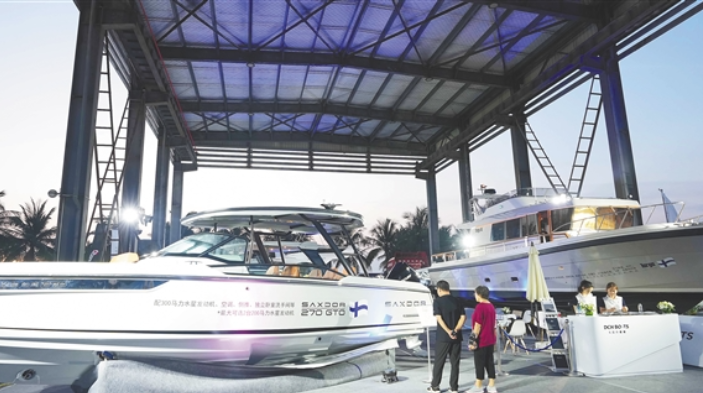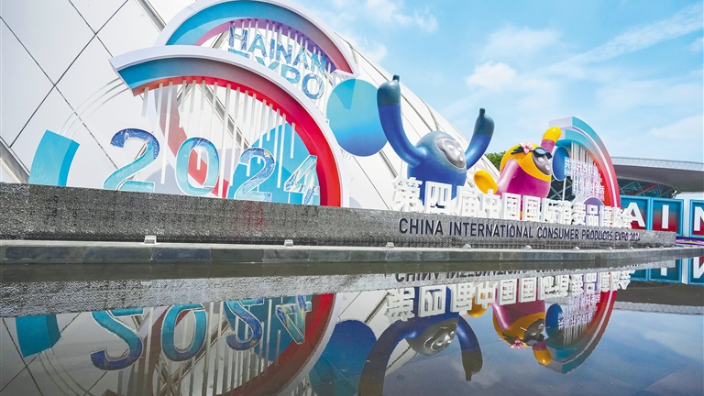By continuing to browser our site and use the services you agree to our use of cookies, Privacy Policy and Terms of Use. You can change your cookie settings through your browser.
There is a team in the Sanya Haichang Animal Conservation Center which has been committed to the conservation and rescue of marine animals since its establishment in December 2018. It is working with local conservation organizations in Hainan Province and Sanya City to rescue stranded dolphins, injured turtles, and other marine creatures and re-release them back into the ocean when they have recovered their health. A total of 30 sea turtles and 10 dolphins have been rescued so far.

A turtle feeding
Out of balance dolphin swims again
In a special pool, a dolphin measuring over 2 meters long is swimming happily. It has been here for half a year.
On the evening of June 15th, on the beach in Jiushuo Town, Ledong Li Autonomous County, this Fraser's Dolphin ran aground on the beach. It was found by passing villagers and then taken to the Sanya Haichang Animal Conservation Center for treatment. At that time, the dolphin’s vital signs were very unstable, and it was suffering from severe dehydration and several traumatic injuries to the surface of its body. Pang Lei, the veterinarian in charge of the Sanya Haichang Animal Conservation Center, said that the most concerning thing was that the dolphin could not keep its balance in the water and was disoriented.
Pang Lei explained that because the dolphin’s breathing hole is located on the top of the head, if the dolphin can not maintain balance, it's easy for it to choke when tilting to one side, which can lead to death.
“We were inspired by floating toys for the swimming pool and tailored a floating support for the dolphin. We tied the float to both sides of the animal with ropes to help it balance," said Pang Lei. He explained that the process is like a human recuperating from a leg injury, first in a wheelchair, then on crutches, and finally returning to walking on his own.
With the help of the tailor-made float, the Fraser's Dolphin gradually regained its ability to swim on its own. After treatment, the vital signs of the dolphin all returned to normal.

A dolphin resting in the pool
A second surgery for a sea turtle’s "intestinal obstruction"
Not far from the Fraser's Dolphin pool, there are several friendly “neighbors”- Sea Turtles. Some of them have lived here for several years, and some have just arrived, but all of them are waiting for the right time to return to the sea. As one of the most ancient animals on the earth, sea turtles have been around for more than 200 million years. However, in recent years, due to human activities, global climate change, and other factors, the sea turtles’ habitat has been damaged, the wild population has continued to decline, and the species continues to face challenges.
A giant female sea turtle measuring about 90 cm. in length and 70 cm in width, and weighing over 200 kg. was treated at the Sanya Haichang Animal Conservation Center.
An initial examination revealed that the turtle had symptoms including rectal prolapse infection and turtle shell rot (an old injury), and blood tests also showed the presence of infection and dehydration. After treatment to restore the turtle’s appetite, the rescue team found a new problem. The turtle had difficulty in defecating. Through a series of tests, the turtle was diagnosed with a "large intestinal obstruction", which required surgery.
During the operation, the veterinarian found that there was a large amount of foreign matter in the turtle's body which was quite difficult to remove. During the 4-hour operation, only about 1 kilogram of foreign matter was removed from the turtle. After considering various factors, the veterinarians decided to end the first operation and wait for the turtle to recuperate for a few days before performing a second operation.
However, after the operation, the turtle’s condition was unfortunately quite poor. “We observed the turtle and found that its vital signs were not good. We carried out anti-inflammatory and rehydration measures immediately, and put it in an isolation medical pool to regain consciousness," Pang Lei said. But unfortunately, on August 26, the veterinarian found that the turtle had no vital signs. After obtaining the consent of higher-level departments, the veterinarians dissected the turtle and removed more foreign objects from its body, including plastic bags, fishing nets, masks, ropes, hooks, and more, totaling about 2 kilograms.
Warming up injured marine animals with love
In the Sanya Haichang Animal Conservation Center, a plaque reading "Aquatic Wildlife Rescue Center of Hainan Province" is prominently displayed, and always inspires the rescue team to never forget their original intention and devote themselves to the rescue, breeding, and protection of marine animals.
There are more than 30 people working in the Sanya Haichang Animal Conservation Center, who are responsible for all aspects of marine animal feeding and conservation, nutritional planning, water quality testing, disease prevention & control, etc. to ensure animal health in all aspects. At the same time, a 24-hour duty system is in place to immediately rush to the scene upon notification and provide rescue services immediately when needed.
Pang Lei, the head of veterinary medicine at Sanya Haichang Biological Conservation Center, has loved animals since he was a child, and chose to major in veterinary medicine in college. “Animals are simple and pure. If you treat them well, they will give the same energy back to you, giving you an indescribable spiritual power," Pang Lei said.
The conservation and rescue of marine animals is not an easy task. When dealing with wounds or feeding the animals, staff are often accidentally hurt by the creatures they seek to help. Pang Lei raised his arm, and a bruise was clearly visible. “When I first rescued the Fraser's Dolphin, it was very scared and kept struggling. I accidentally hit the wall of the rescue pool," Pang Lei said. Although the rescue process was very difficult, he still felt that everything was worth it.
The accumulation of 3 kilograms of marine garbage in the body of a giant turtle sounded an urgent alarm to protect the marine environment. “Plastic bags, fishing nets, and other garbage look very similar to jellyfish when floating in the water. Turtles cannot tell them apart, so they often eat plastic bags and other garbage, thinking they are eating jellyfish.” Pang Lei said that even if the turtles realize that they are eating garbage instead of food, it is difficult for them to spit it out.
"The survival crisis faced by sea turtles is directly related to the destruction of the marine environment by humans, and we have the responsibility and obligation to act immediately to guard the marine environment together and keep marine animals from harm," said Pang Lei.

A staff member interacts with a dolphin in the water.
16 New Measures Set to Make Life in Hainan for Foreigners Easier
08:10, 18-April-20244th CICPE Helps Hainan’s Yacht Industry Development
03:37, 18-April-2024New friends, new opportunities at the Hainan Expo
03:37, 18-April-2024Fáilte go Hainan! FTP Becomes Top Destination for Irish Firms
03:37, 18-April-2024Michael's EV Journey in Haikou
03:37, 18-April-2024OCOs on Expo: Inira’s magical Hainan Expo journey
06:01, 17-April-2024By continuing to browser our site and use the services you agree to our use of cookies, Privacy Policy and Terms of Use. You can change your cookie settings through your browser.





